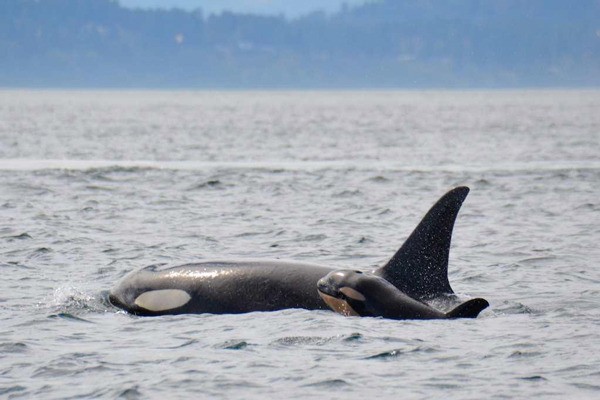— Submitted by the Orca Behavior Institute
As K- and L-Pods made their way into Haro Strait on Labor Day, researchers and whale-watchers spotted a new addition to the community: L122, identified by the Center for Whale Research as the first-born calf of 20 year-old L91, also known as Muncher. This new baby is the fifth one born to the endangered Southern Residents in the last nine months, following a period of over two years without a successful birth. While the whale community is understandably excited about the births, their arrival also means there are more mouths to feed.
In May of 2015 National Oceanic and Atmospheric Administration featured the Southern Resident Killer Whales as one of eight “Species in the Spotlight,” a report to Congress that identifies listed species at the greatest risk for extinction in the near future. The reality is these little ones will only survive and thrive if the biggest issue facing the Southern Residents is addressed, and soon. Without an increase in abundance of their primary prey, Chinook salmon, it is unlikely this population of whales is going to recover.
The Southern Residents were listed under the Endangered Species Act ten years ago, however their population has continued to decline. The Salish Sea is known as the core summer habitat for the Southern Residents, but in fact they regularly range from British Columbia to California and rely on all the major salmon rivers in the region, particularly the Fraser and Columbia-Snake River Basins.
Many of these salmon stocks are also listed as threatened or endangered, and millions of dollars of recovery efforts have yielded little in the way of results. “There’s a lot of cutting edge research being done by NOAA scientists and others to determine exactly what these whales are eating when and how it’s affecting their nutritional status,” said Monika Wieland, executive director of the Orca Behavior Institute in Friday Harbor. “With the Southern Residents being featured in the Species in the Spotlight, it’s clear that these studies need to inform immediate management actions to help these whales. If there isn’t enough data to take action, then there needs to be more funding to help this important research expand.”
One of the biggest actions that could be taken to recover Pacific Northwest salmon is to breach the four Lower Snake River dams. These dams are widely recognized as no longer serving their intended purpose and as being costly both in terms of taxpayer dollars and their negative impacts on wild salmon. President Obama has been briefed on the issue, and has the power to issue an executive order to breach the dams, which would directly and immediately benefit people, salmon, and orcas.
The newly formed Orca Salmon Alliance , a group of ten regional, national, and international environmental organizations, brings together many different voices advocating for dam removal on behalf of the Southern Residents. OSA will be hosting “Intertwined Fates: The Orca-Salmon Connection in the Pacific Northwest” at the Seattle Aquarium in Oct. 7, with keynote speaker Dr. Carl Safina.
“We are ecstatic to have a new calf in the population, but it’s important to look at the bigger picture,” said Orca Behavior Institute lead researcher Michael Weiss. “This new calf, if it survives, makes 5 calves this year. We know from the Center for Whale Research census data that the average for the last 35 years has been just over 3 calves per year, but this year follows over two years in which we had no new surviving calves. The whales are barely breeding at replacement rate, when what we really need is population recovery. For this population, and L122, to grow and flourish, the main limitation, a lack of food, must be addressed.”



